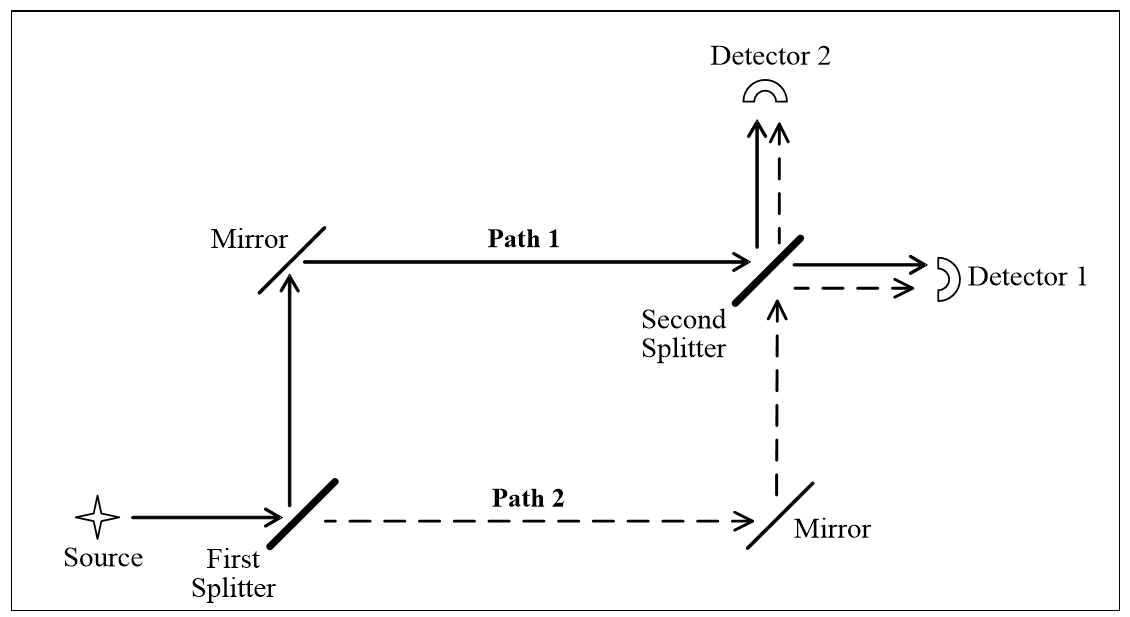Using quantum theory, physics has discovered how to detect an object without physically touching it, which in a purely physical world should be impossible. The amazing device that does this is called a Mach-Zehnder interferometer (Figure 3.22).

This device works as follows. First, it splits light into two paths that go to the two detectors, where the mirrors make the paths cross. The result is that each detector fires half the time, as expected. Then a second light splitter is added where the paths cross to split the light again. If half the light shining on the first splitter goes down path 1, and half goes down path 2, then adding a second splitter splits the light again, half to each detector, so there are four paths to the two detectors. Light going down path 1 goes to both detectors, as does light going down path 2, so how do they respond?
The result is that detector 1 still fires but detector 2 never does! There is no physical explanation for this, but quantum theory explains it, based on quantum waves, as follows:
As photon waves evolve down the paths, each mirror or splitter turn delays its phase by half. Both paths to detector 1 have two turns, so they add because they are in phase. In contrast, path 1 to detector 2 has three turns while path 2 has two, so they cancel out because they are out of phase. Detector 2 then never fires because the waves from the two paths to it always cancel.
This setup then allows a very unusual result. If a light sensitive object is put on path 2, the previously silent detector 2 sometimes fires, even when the object didn’t detect any light. This never happens if path 2 is clear, so this proves there is an object on path 2, yet no light went that way. The results (Kwiat et al, 1995) are unequivocal:
1. With two clear paths, only detector 1 fires.
2. If an object blocks path 2, detector 2 sometimes fires, even when no light touched the object.
Quantum theory then explains what materialism can’t (Audretsch, 2004), p29, as follows:
Light waves evolve down both paths, so they hit the path 2 object half the time. The other half of the time they go down path 1, but if path 2 is blocked, the waves to detector 2 no longer cancel out, so it fires sometimes, even when the path 2 object registers no light. Detector 2 then only fires if there is an obstacle on path 2.
To illustrate how strange this is, suppose a light sensitive bomb blocks path 2 but the experimenter doesn’t know this. If he is lucky, sending one photon down the system will trigger detector 2, proving the bomb is there, yet it didn’t go off. This isn’t a good bomb detection technique, as half the time it sets the bomb off, but it proves that it is possible to detect a bomb without touching it!
In our world, light can detect a physical object it didn’t touch, but how can it detect a bomb on a path it didn’t take? Table 3.2 shows the four paths that quantum waves can take with their hit probability. As shown, half the time the bomb goes off, sometimes detector 1 fires, but sometimes detector 2 fires without triggering the bomb. The latter shows the bomb is there because it blocked the quantum wave that normally prevents detector 2 from firing.
Non-physical detection proves that quantum waves exist, because matter can’t do this.
|
Table 3.2. Quantum Wave Paths |
|||
|
Path |
Probability |
Result |
|
|
No Bomb |
Path 2 Bomb |
||
|
Path 1 to Detector 1 |
25% |
Detector 1 fires |
Detector 1 fires |
|
Path 2 to Detector 1 |
25% |
Detector 1 fires |
The bomb goes off |
|
Path 1 to Detector 2 |
25% |
Detector 2 never fires |
Detector 2 fires but the bomb doesn’t go off |
|
Path 2 to Detector 2 |
25% |
Detector 2 never fires |
The bomb goes off |